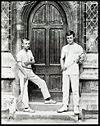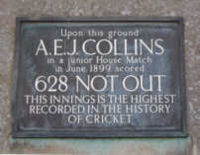A. E. J. Collins
2008/9 Schools Wikipedia Selection. Related subjects: Sports and games people
| Arthur Edward Jeune (James) Collins | |
|---|---|
| 18 August 1885– 11 November 1914 | |
 A. E. J. Collins |
|
| Place of birth | Hazaribagh, India |
| Place of death | Ypres, France |
| Allegiance | British Army |
| Years of service | 1902—1914 |
| Rank | Captain |
| Unit | Royal Engineers |
| Battles/wars | First Battle of Ypres |
| Relations | Brother, Herbert; Spouse, Ethel Slater |
Arthur Edward Jeune (James) Collins ( 18 August 1885– 11 November 1914), typically known by his initials AEJ Collins, was an English cricketer and soldier. He is most famous for achieving the highest-ever recorded score in cricket: as a 13-year-old schoolboy, he scored 628 not out over four afternoons in June 1899. Collins' record-making innings drew a large crowd and increasing media interest; spectators at the Old Cliftonian match being played nearby were drawn away to watch the junior school house cricket match in which Collins was playing.
Collins joined the British Army in 1902. He studied at the Royal Military Academy, Woolwich, before becoming an officer in the Royal Engineers. He served in France during World War I, where he was killed in action in 1914.
Early life and education
Collins was born in Hazaribagh, India, to Arthur Herbert Collins, a judge in the Indian Civil Service, and Mrs Esther Ida Collins. Both of his parents had died by the time he began his education at Clifton College, Bristol, where he held a scholarship.
He joined Clifton College in September 1897, becoming a member of Clark's House, although he later moved to North Town house. Clifton had an excellent reputation for sport. W.G. Grace scored 13 first-class centuries at the school ground, Clifton Close, and he sent his sons to the school. Collins was an excellent sportsman, being in the football XI (eleven being the number of players in the team), the rugby union XV, and the cricket XI, and he represented the school in the racquets pair in 1902 with R. P. Keigwin. He won a bronze medal for boxing at Aldershot in 1901, along with E. A. Hughes and H. P. Hewett.
Tim Rice, in an article for the electronic telegraph on 9 June 1999 to celebrate the centenary of the score, entitled "On the seventh day AEJ Collins rested", described him thus:
| “ | He was an orphan whose guardians lived in Tavistock, Devon. He was a reserved boy, short and stockily built, fair-haired and pale. He was remembered by contemporaries as one who led by example, rather than by inspiration, although paradoxically he was regarded as likely to fall short of the highest standards as a cricketer because of his recklessness at the crease. | ” |
The famous match
In 1899, whilst a 13-year-old schoolboy, Collins scored the highest ever recorded cricket score of 628 not out. This feat took place during a junior school house cricket match between Clarke's House and North Town house. Such matches were timeless, played to a finish however long they took. The match was played on an outfield off Guthrie Road, Bristol, now named Collins' Piece. The ground had both a poor surface and a very unusual shape: it was very short (only 60 yards (55 m) long), with a wall only 70 yards (60 m) away forming the boundary on one side, while the other side was a gentle slope falling away towards the school sanatorium in the distance. All hits to the long boundary, down the slope, had to be all-run, but the three short boundaries only counted for two runs.
On Thursday, 22 June, Collins, a right-handed batsman, won the toss for Clarke's House and chose to bat first. Collins hit his first stroke at 3.30 p.m. By the close of play at 6 p.m., he had scored 200 runs, having been dropped on 80, 100 and 140.
School lessons allowed another two-and-a-half hours' play on Friday, 23 June, and by then news of an exceptional innings had gone round the school. So brilliant was his play that even the crowd watching an Old Cliftonian match being played nearby lost its interest and a large crowd watched Collins' phenomenal performance. Collins' innings almost ended at 400 when an easy catch was dropped by the youngest player on the field, 11-year old Victor Fuller-Eberle, but at around 5.30 p.m., after batting for around five hours, rapturous applause broke out when he passed Andrew Stoddart's world-record score of 485. At the end of the second day, he remained unbeaten on 509 and the team on 680 for 8. His innings was reported as a world record in The Times newspaper on Saturday June 24; the paper, however, gave Collins's score by the close of play on Friday as 501, his age as 14 and mis-reported his name as "A. E. G. Collins".
The match resumed in the lunch hour on Monday, 26 June, at 12.30 p.m., with a large crowd. By the end of play, Collins had been dropped again, on 556, to reach 598, but another wicket had fallen, and Collins was rapidly running out of partners. On Tuesday, 27 June, the school authorities extended the hours available for play in an attempt to finish the match. The crowds grew and media interest escalated, with The Times again reporting on the match on Tuesday, and the disruption to school life was considerable. Collins hit out, with his approach being described as "downright reckless". He was dropped twice more, on 605 and 619. After just 25 minutes' play, Collins lost his final partner, Thomas Redfern, caught by Victor Fuller-Eberle at point for 13, with Collins' score on 628. Collins had played less than seven hours' cricket, carrying his bat through his side's innings. He had scored 1 six, 4 fives, 31 fours, 33 threes, 146 twos and 87 singles. The Times once again ran a report, giving the final figures for Collins's innings in its Wednesday June 28 edition — once again, however, they misspelled his third initial.
North Town house, demoralised, were bowled out for 87 in 90 minutes on Tuesday. The match resumed on Wednesday 28 June, when North Town's second innings went even worse, making 61 in just over an hour, so Clarke House won by an innings and 688 runs. Collins showed some ability as an all-rounder, with his right-arm medium pace bowling taking 11 wickets for 63 runs.
The scorebook hangs in the pavilion at Clifton to this day. The scorers faced a difficult task in accurately recording the innings. One of them, Edward Peglar, is said to have remarked that Collins's score was "628, plus or minus twenty shall we say". The other scorer for the match was J.W. Hall, whose father in 1868 had batted with Edward Tylecote, who later played Test cricket for England and whose name is on a poem kept with the Ashes urn. Tylecote had earlier set a world-record score of 404 not out in 1868, also at Clifton. Hall later wrote that "The bowling probably deserved all the lordly contempt with which Collins treated it, sending a considerable number of pulls full pitch over the fives courts into the swimming baths to the danger of the occupants."
Collins became public property for a long while after the match, forever associated with his great score. "Today all men speak of him," wrote one newspaper, "... he has a reputation as great as the most advertised soap: he will be immortalised." After leaving school, he never wanted to be reminded of his famous innings; nevertheless, he has been remembered well beyond his own lifetime.
Within 2 years, 31-year-old Australian Test cricketer Charles Eady came close to breaking the record, when he made 566 for Break-o'-Day against Wellington in Hobart in less than eight hours spread over three weeks in March 1902. This remains the closest challenge to Collins' record: only four other players, Dadabhoy Havewala (515), JC Sharp (505*), Malhotra Chamanlal (502 not out), and Brian Lara (501*) have ever scored more than 500 runs in one innings in any form of cricket; Lara is the only person to have achieved a score of over 500 runs in first-class cricket.
Military career
Collins chose to follow an army career, passing his entrance exams to the Royal Military Academy, Woolwich in September 1901 and representing the Royal Military Academy at both football and rugby as well as cricket, scoring a century in a match against Sandhurst. He joined the British Army the following year, being commissioned as a Second Lieutenant in the Royal Engineers in 1904. Despite the limitations on his sport that the military service caused, he played several matches for Old Cliftonians, his regiment, and the Army, remaining a free-hitting batsman. He played at Lord's in 1913 for Royal Engineers against Royal Artillery, scoring 58 and 36 runs in the two innings, but he never played first-class cricket. He also joined Clifton Rugby Football Club in February 1905, but never rose above the 2nd XV. He served with the 2nd Sappers and Miners in India, and was promoted to Lieutenant in 1907.
He married Ethel Slater in the spring of 1914, and was sent to France when World War I broke out later that year. He was killed in action, as a Captain, on 11 November 1914 at the First Battle of Ypres, while serving with the 5th Field Company, Royal Engineers, at the age of 29. He was signalling for more men to protect the flank of his trench when he was killed, his body was dragged back into the trench by Sapper Farnfield (23900). The 5th Field Company carried out the burials of its Company on the 12th November. Due to the continual fighting over this area for the next four years what remained of his grave and remains were never found, but his name is recorded at the Menin Gate Memorial in Belgium. Before his death, he had been Mentioned in Dispatches. His younger brother Herbert (a Lieutenant in the 24th Battalion of the Manchester Regiment and also an old Cliftonian) was killed in action on 11 February 1917, aged 27. Collins's wife, Ethel, lived as a widow for over fifty years, dying on September 1, 1966 in Haslemere.

